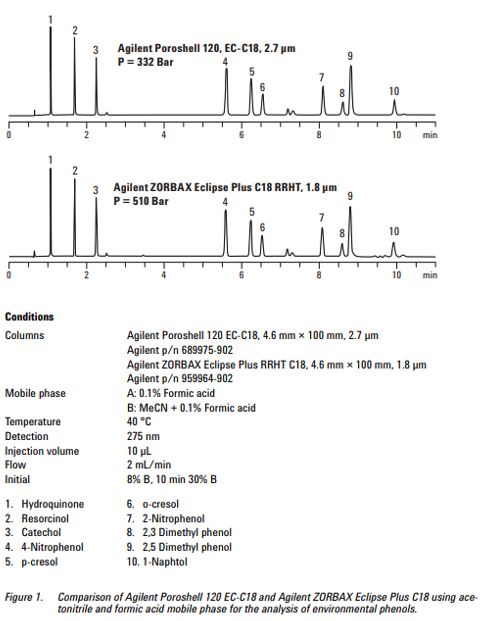Posted by Chrom Tech on 14th Oct 2025
Method Transfer between Poroshell and Zorbax HPLC Columns
Superficially porous particle (SPP) HPLC columns offer one of the most effective ways to achieve high chromatographic efficiency without the excessive backpressure typically associated with sub-2-μm fully porous columns. This makes SPP technology an ideal choice for analysts seeking faster separations, sharper peaks, and improved throughput—all while maintaining compatibility with conventional HPLC systems.
Poroshell vs. ZORBAX Columns
Agilent’s ZORBAX columns have long been trusted in chromatography labs for their consistent performance and chemistry versatility. Building on that success, Agilent introduced the Poroshell series—HPLC columns based on superficially porous particle technology that replicate ZORBAX chemistries while providing superior pressure control and speed.
When comparing Poroshell 120 EC-C18 columns with ZORBAX Eclipse Plus C18 RRHT, chromatographers observe nearly identical separations with substantially lower system backpressure. This efficiency allows users to transfer existing methods seamlessly while extending system longevity and reducing wear on pumps and seals.

Because the bonding chemistries between the two lines are similar, method transfer from sub-2-μm totally porous to SPP columns often requires little to no adjustment. Chromatographers can maintain retention characteristics, selectivity, and resolution while lowering operational pressure—a significant advantage for labs optimizing existing validated methods.
Why Switch Columns If the Chemistry Is So Similar?
Even though the chemistries are nearly identical, Poroshell columns provide additional flexibility and performance benefits. With lower operating pressures, analysts can:
- Increase flow rates to achieve higher sample throughput.
- Use longer columns to enhance resolution without exceeding system pressure limits.
- Extend the lifetime of HPLC instruments by reducing overall mechanical strain.
For laboratories focused on productivity, these advantages make Poroshell columns a compelling upgrade path—especially when working within legacy HPLC pressure constraints.
A Closer Look at the Inlet Frit Design
Another critical feature of Agilent Poroshell columns is their optimized inlet frit design. Many sub-2-μm columns use inlet frits as small as 0.2–0.5 μm, which are prone to clogging—especially when working with complex matrices. Poroshell columns, by contrast, feature a 2 μm frit, allowing improved flow and reduced risk of blockage.
This design significantly enhances column durability and minimizes maintenance downtime, offering a longer usable lifespan and greater return on investment compared to traditional small-frit designs.
Conclusion
As HPLC technology continues to advance toward smaller particle sizes and higher resolution separations, Agilent’s Poroshell 120 columns provide a powerful balance of performance, efficiency, and system compatibility. They deliver the high resolution of sub-2-μm columns without the need for ultra-high-pressure instrumentation.
Transitioning from fully porous to superficially porous particle columns is typically straightforward, with minimal or no method modification required. For laboratories looking to enhance speed, performance, and column lifetime, Poroshell SPP columns represent a smart, future-ready investment.
To learn more about ZORBAX HPLC columns, Poroshell columns, or to speak with one of our chromatography specialists, visit Chrom Tech today.
Source: Agilent White Paper – Transfer of Methods between Poroshell 120 EC-C18 and ZORBAX Eclipse Plus C18 Columns (5990-6588EN)
Frequently Asked Questions About Poroshell Columns
What is the main advantage of Poroshell columns over traditional fully porous columns?
Poroshell columns use superficially porous particles that deliver the same high efficiency as sub-2-μm fully porous particles but with significantly lower backpressure, making them compatible with conventional HPLC systems.
Do I need to modify my existing HPLC method to switch to Poroshell columns?
In most cases, no. Because Poroshell and ZORBAX columns share similar bonding chemistries, existing methods can usually be transferred directly without altering parameters or revalidating conditions.
How does the 2 μm frit in Poroshell columns improve performance?
The larger 2 μm frit reduces clogging and extends column lifetime, ensuring more consistent flow and lower maintenance frequency compared to sub-μm frit designs in other columns.

